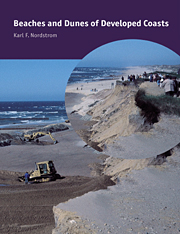Book contents
- Frontmatter
- Contents
- Preface
- Acknowledgements
- 1 The developed coastal landscape: temporal and spatial characteristics
- 2 Altering landforms to suit human needs
- 3 Replenishing landforms
- 4 Effects of structures on landforms and sediment availability
- 5 Characteristics of human-altered coastal landforms
- 6 Temporal scales of landscape change
- 7 Management programs
- 8 Maintaining and enhancing natural features in developed landscapes
- 9 Directions for geomorphological research
- References
- Index
6 - Temporal scales of landscape change
Published online by Cambridge University Press: 18 December 2009
- Frontmatter
- Contents
- Preface
- Acknowledgements
- 1 The developed coastal landscape: temporal and spatial characteristics
- 2 Altering landforms to suit human needs
- 3 Replenishing landforms
- 4 Effects of structures on landforms and sediment availability
- 5 Characteristics of human-altered coastal landforms
- 6 Temporal scales of landscape change
- 7 Management programs
- 8 Maintaining and enhancing natural features in developed landscapes
- 9 Directions for geomorphological research
- References
- Index
Summary
Introduction
Many of the scale effects of differences between natural and human-altered landforms are treated in earlier chapters, where the emphasis was placed on the initial modification to the landforms or to their characteristics at one point in time. This chapter discusses the evolution of landforms and highlights changes associated with major meteorological and climatological inputs, contrasting the ability of natural processes to cause coastal changes and the ability of human agency to reconstruct the cultural landscape. Temporal cycles of change related to major storms, seasonal changes in wind and wave intensities and long-term changes in sea level are contrasted with cycles related to human uses and management. Alternative models (or scenarios) of change for developed coasts are then examined to indicate the different ways that the role of humans in landscape change is perceived and evaluated.
Effects of storms on evolution of developed coasts
Perspective
Types of studies
There are many studies of the geomorphological and engineering implications of specific storms (Hayes 1967; Dolan and Godfrey 1973; Morton 1976; Penland et al. 1980; Dean et al. 1984; Nakashima 1989; Finkl and Pilkey 1991; Kraus 1993; Finkl 1994; Stone and Finkl 1995), and at least one major study of shoreline changes is published following each hurricane in the USA (Morton 1976). Most of these studies are reconnaissance-level investigations that are conducted within a few months of storm passage, and descriptions of post-storm recovery are often limited to a paragraph or two near the end of a litany of damages (Nordstrom and Jackson 1995).
- Type
- Chapter
- Information
- Beaches and Dunes of Developed Coasts , pp. 165 - 191Publisher: Cambridge University PressPrint publication year: 2000
- 1
- Cited by



